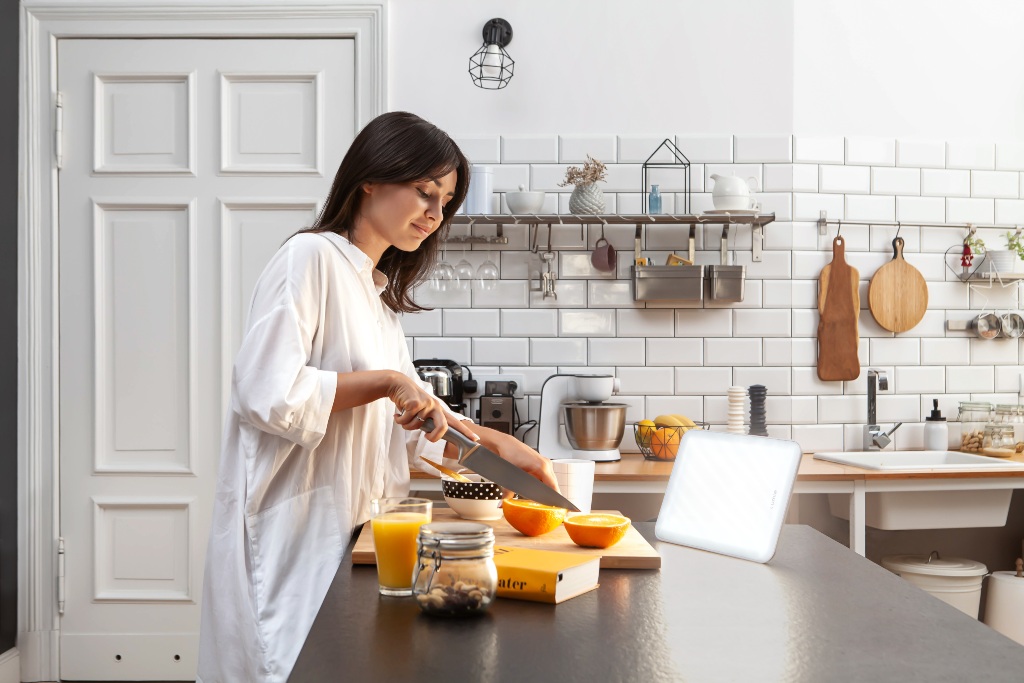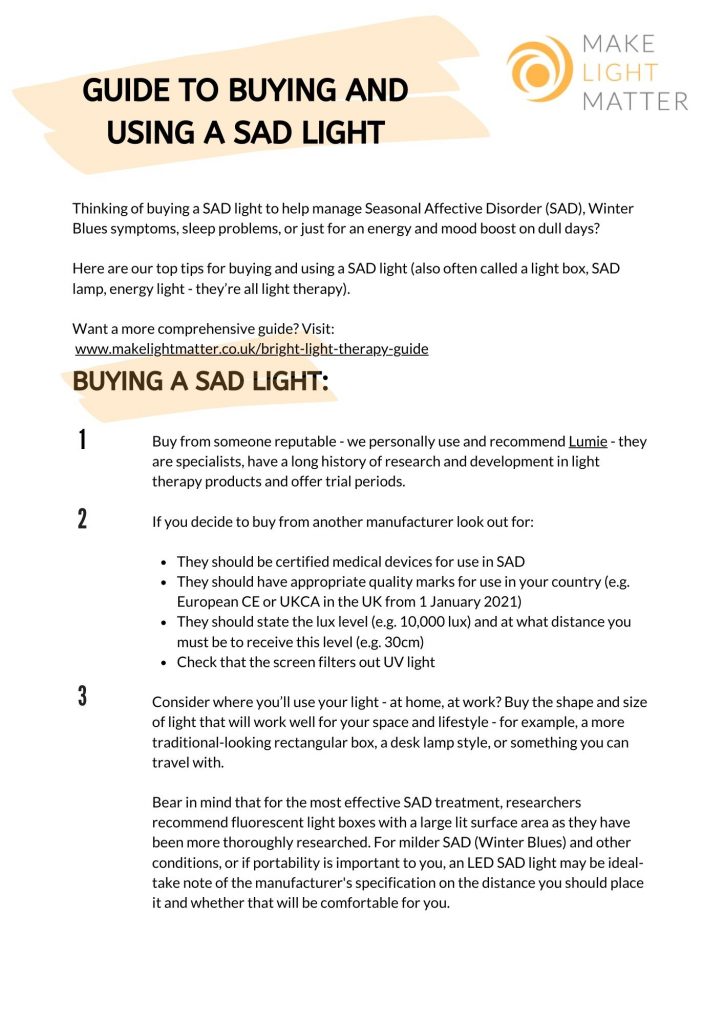Thinking of buying a SAD light to help manage Seasonal Affective Disorder (SAD), Winter Blues symptoms, sleep problems, or just for an energy and mood boost on dull days?
Read on for our top tips for buying and using a SAD light (also often called a light box, SAD lamp, energy light – they’re all light therapy).
Want a printable version? Click on the image to download a PDF version that you can save or print.
Have more questions or want more in-depth guidance? Take a look at our comprehensive guide to bright light therapy.
Buying a SAD light
Buy from someone reputable – we personally use and recommend Lumie – they are specialists, have a long history of research and development in light therapy products and offer trial periods.
If you decide to buy from another manufacturer look out for:
- They should be certified medical devices for use in SAD
- They should have appropriate quality marks for use in your country (e.g. European CE or UKCA in the UK from 1 January 2021)
- They should state the lux level (e.g. 10,000 lux) and at what distance you must be to receive this level (e.g. 30cm)
- Check that the screen filters out UV light
Consider where you’ll use your light – at home, at work? Buy the shape and size of light that will work well for your space and lifestyle – for example, a more traditional-looking rectangular box, a desk lamp style, or something you can travel with.
Bear in mind that for the most effective SAD treatment, researchers recommend fluorescent light boxes with a large lit surface area as they have been more thoroughly researched. For milder SAD (Winter Blues) and other conditions, or if portability is important to you, an LED SAD light may be ideal- take note of the manufacturer’s specification on the distance you should place it and whether that will be comfortable for you.
Using a SAD light
This is a guide that will suit most people, but be prepared to experiment with what works best for you. If you have a bipolar presentation of Seasonal Affective Disorder your doctor may give you slightly different instructions and ask you to take a mood stabilising medication before beginning bright light therapy.
When to use your SAD light:
- Use your light in the morning within two hours of waking, when possible
- Have a top-up session in the afternoon if you feel like you need it (your energy and/or mood is low)
- Don’t use your light in the late evening and night as it will stop you sleeping
Where to position your SAD light:
- Position your light on a stable surface, following your manufacturer’s instructions on distance, or if available, use a stand to position it shining down on you like a rising sun for really optimal effect
- Put your light somewhere you regularly sit or plan to sit still for a length of time – e.g. a dining table, breakfast bar, side table, a desk
How to use your SAD light:
- Switch your light on and do your normal activity (e.g. eating, working, reading, watching TV, crafting) having the light slightly off to the side (think 11 o’clock or 1 o’clock), allowing the light to reach your eyes but not staring at it
- Your eyes need to be open and you can wear prescribed glasses or contact lenses, but not dark sunglasses or blue light blocking glasses
- Treatment length varies depending on the strength and size of the light, how close it is and your individual needs, but a good general guide is a 10,000 lux light at 30cm for 30 minutes
- If sitting for a full treatment isn’t practical, consider splitting it into several shorter bursts through the daytime
Watch-outs when using your SAD light:
- If you start feeling ‘wired’ or very hyperactive, and/or get headaches, stop using your box and try building up more gradually
- If you or your loved ones are concerned about sudden hyperactive behaviour contact a doctor immediately
- Some medications, alternative remedies and other health conditions can make your eyes or skin more sensitive to light – for example, St John’s Wort, a herbal remedy often taken to reduce depression, can cause you to be photosensitive. Stop light treatment and speak to a doctor if you experience any skin burning, rash, eye discomfort or headaches/migraines
Make Light Matter always recommends discussing your symptoms and intention to use light therapy products with your GP. They can help you rule out other conditions that produce similar symptoms, check for contra-indications like taking medicines or other conditions that make you more light-sensitive. If you have bipolar disorder (with or without seasonal pattern) they may want you to take a mood stabilising medication before starting light therapy.
Light therapy is just one way that you can meet your light nutrition needs. Tuning into how you feel in different environments and making some behavioural, mindset and environmental changes to suit your own individual needs is what we call ‘living your light ideal‘.
Got a comment or question? Comment below or drop us an email and we’ll do our best to help.
Image credits and notes
Thank you to Lumie for providing images of some of their products for our use. We don’t have a commercial relationship with Lumie, but the team has been very supportive of Neina’s work over the years as Little Light Room and Make Light Matter.


